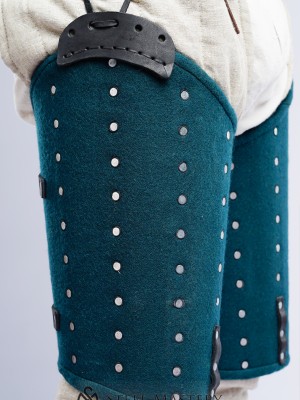Roman Subarmalis with Pteruges IV- VII century
HG-53
Total
€180
Shipping costs will be added to the order price after adding it to the cart and specifying of your location. Delivery price depends on the region and ordered item.
Roman Subarmalis with Pteruges IV- VII century
Custom made
This item is a custom-made, which means that our crafters use individual body measurements of a client for manufacture. Such type of manufacturing provides with a perfect fit of an item.
description
Subarmalis is a quilted garment worn under armor.
Suitable for several periods of Roman history from the 4th to the 7th century.
During the 4th century, Subarmalis was probably exclusively for the wealthy. But from the 6th and 7th centuries, it was used by all segments of society in the army.
There are no archaeological sources that can be used to reconstruct the Subarmalis. Unfortunately, visual sources which shows the body of a subarmalis, or of any other kind of padded armour, for Late Antiquity are quite rare and difficult to find. So, to have a more complete overview on the matter, to previous and later sources.
There are two main different kinds of quilting.
Then first one consists of vertical sewing lines, much like later medieval gambesons. We have really clear example of it from the stelae of the soldier Severius Acceptus, from Chalcedon, dated to the 3rd century AD, and possibly (caution here is a must) on the stelae of Lepontius, now in Strasbourg, dated to the 4th century AD.


Details from the stelae of Severius Acceptus (left) and Lepontius (right).
Another possibility was a quilting which formed a lozenge pattern. This kind of quilting is already visible on the 1st century AD stelae of the centurion Titus Calidius Severus, and we also find it on a soldier’s probable padded armour on a sarcophagus from Split, possibly to be dated to the 4th century. We also can find the same kind of quilting also in much later, Eastern Roman sources, such as a 12th century silver dish on which St. George is depicted, and a 13th-14th century icon showing St. Demetrius. Even though we know on many occasions probably icons of warriors saints do not reproduce the real military equipment of the period they were created, we can at least hypothize that this kind of quilting was also used during the period in between the sources mentioned above.


Details from the stelae of Calidius Severus (left) and from the Split sarcophagus (right).


Depictions of Saint George (12th century) on the left, St. Demetrius (13th-14th century) on the right.
Shape of pteryges
Even if pteryges are usually the only visible part of the subarmalis, this does not makes them any easier for determining how they were – and in fact, the debate about this matter is still open.
A shape that is visible in some visual source from the 6th and 7th century (but already to be found in the 4th-5th, and even in previous periods), with the end of the pteryges in semicircular shape
If you don’t like the received product for any reason, you may send it back to us within 14 days. If the received item has defects or does not fit your parameters, we will make a new item and send it to you at our costs. If postal service lost your parcel, we make a search of it. If parcel could not be found, we make new item at our expenses.
We ship orders via National Postal Service, who carries order to your local post office. Upon shipping, we provide you with tracking number of parcel. If you need express delivery (DHL, TNT, etc.), please contact us.
Every product is handcrafted and requires time for manufacture. Approximate time:
- Gambeson and padded armor – 8-9 weeks;
- Costumes and other clothing – 4-6 weeks;
- Brigandines – 3-4 months;
- Leather accessories 2-4 weeks;
- Metal armor – 2-5 months.
Please contact us if you would like to know more precise terms.

-0-1-0-1-1-228x228.jpg)
-0-1-0-1-1-100x118.jpg)
-0-1-0-1-1-100x118.jpg)
-0-1-0-1-1-100x118.jpg)
-0-1-0-1-1-100x118.jpg)
-0-1-0-1-1-100x118.jpg)
-0-1-0-1-1-490x648.jpg)
-0-1-0-1-1-490x648.jpg)
-0-1-0-1-1-490x648.jpg)
-0-1-0-1-1-490x648.jpg)
-0-1-0-1-1-490x648.jpg)
-0-1-0-1-1-490x648.jpg)



